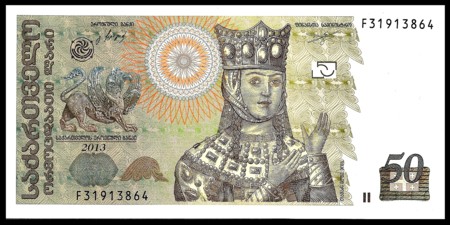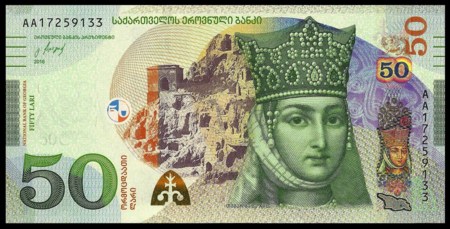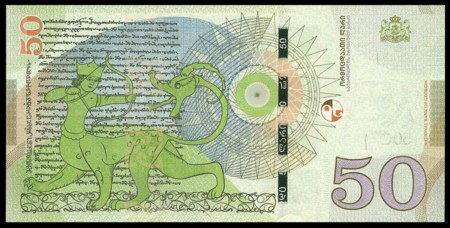GEORGIA
Tamar – The Lady King

In 1166, a princess named Tamar was born in the country of Georgia. Her father was King George III, who had been king for four years by the time she was born. For several years she lived a life of what would assuredly have been normal for a princess, but at the young age of 12, events occurred that would change her life forever.
In the year 1177, when Tamar was 11 years old, the Georgian King, George III, was being challenged by a rival nephew, Demna, who claimed to have the direct line of heritage for the throne. Demna’s Father, David V, had overthrown his father, Demetrius I, and taken the Georgian throne from him in 1154. David V did not rule long. Historians vary from a mere six-months to two years, when David V died under mysterious circumstances in 1155. When his father died, Demna expected to receive the crown, but his grandfather, Demetrius I, was still alive, and he regained the throne and ruled again until his death in 1156. Just before his death, Demetrius I declared his younger son, George III to be the heir. Thus, Demna was feeling cheated again and he sought support for his claim to the throne.
Demna was backed by a few powerful nobles, and in 1160 he was able to try for a coup, like his father had before him. King George III, however, was able to defeat the uprising rather easily and, after defeating Demna, George III sought out those who had backed him and either had them killed or banished from Georgia. As for Demna, he was blinded and castrated and thrown into prison, where he died shortly thereafter.
Amongst all this clatter was George III’s daughter, Tamar. To avoid such attempts against his family’s claim to the throne in the future, George III made a promise that he would share the throne with his newborn daughter when she reached 12 years of age. In 1178 Tamar was appointed as co-ruler with her father, George III, and they ruled together for six years until George III died in 1184, when Tamar became the ruler of Georgia at age 18.
In the Georgian language, her title was Mep’e, meaning king, sovereign, ruler, etc. The title Dedop’ali, which means queen, is rarely used for Tamar. The reason for this is because a queen was seen as a secondary ruler, and not the position of the highest ruler. So Mep’e is the title, which is why she is often referred to as the female king.
Her inheritance of the crown and the sole ruler came with the expected jockeying for power amongst the lower nobles and court appointees. She was forced to remove some people and to award others, but in all, she was able to maintain her authority and position.
One of the things that her court and nobles forced her into accepting was a new husband. It was explained to her that by taking a husband, she would have a male to assume command of the military forces and to provide the kingdom with an heir upon her death. While likely hoping to also have this new spouse assume a great part of the rule, they recommended a man named Yuri. They were thus married, and while he was indeed a capable soldier and commander, winning many battles, he was also evidently a drunkard and fond of immoral sexual deeds. Tamar meanwhile expanded her court and reasserted her power, gaining enough support to demand that her marriage to Yuri be nullified, and she was granted a divorce, banishing Yuri to Constantinople. Tamar then married a man named David Soslan Bagrationi, who would prove to be a much better husband. In 1192 they had a son, George, and in 1195 they had a daughter, Rusudan. George would assume the throne in time, and after his death in 1223, Rusudan would also assume the throne, as her mother did. She would not be able to hold on to her power for long, losing much to the Khwarezmians, a larger kingdom to the east, and later to the Mongols.
In 1195 Abu Bakir, a Persian, was attacking her forces, and she activated the army in 10 days’ time. While the army was off fighting, Tamar climbed, bare footed, up a hill to the Metekhi Church where she kneeled and prayed without stop to the Virgin Mary, until word arrived of the Georgian victory. After this battle, with her trusted husband by her side, Tamar was able to consolidate her power and start an active expansionist campaign. The Georgian forces were very successful, drawing the attention of the Muslim world, especially the Sultan of Rum (located in Turkey) who, in 1203, positioned his forces ready for attack. He sent an emissary to Tamar, who spoke to her in a most arrogant manner, demanding a surrender without fight. He told Tamar that the Sultan of Rum would agree to marry her if she were to forsake Christianity and adopt the Islamic faith but, if she did not adopt Islam, he would place her in his harem. After the emissary spoke this, a nobleman from Tamar’s court walked up to the emissary and struck him to the ground. Tamar then sent the emissary away with a letter telling the Sultan of Rum that she would place her trust in the will of God alone.
Assembling the army, Tamar prayed again to the Virgin Mary, and then evidently led her army herself, and again barefooted, onto the battlefield. Though she did not participate in the fighting personally, the Sultan and his forces were driven back and defeated.
Tamar continued her expansionist campaigns, but also devoted a lot of time to prayer and also to helping the poor and building churches. She devoted herself to certain practices, such as praying bare footed, sleeping on a stone bed, fasting, etc. and donated her embroidery work to the poor.
Tamar’s consort, David, died before her, and Tamar, not long after she abdicated the crown to her son George, died herself in 1213. Tamar’s reign was extremely popular, as it expanded the nation and culture of the Georgian people. She enacted laws, repealed the death penalty, and forbade torture of the people. Over time, she was elevated as a blessed ruler, who was later canonized by the church, and became the subject of several famous poems, stories, and songs. Her idealization of a saintly ruler was reinforced with the discovery in the 1840’s of contemporary frescos of Tamar in the Batania Monestary, showing Tamara flanked by her father, George III and her son George IV. These frescoes were cleaned and restored and generated a nationalistic fervor which has lasted into the modern age. Today, Tamar is featured on the 50 Lari currency.



